Ladakh’s contribution to
the Silk Road
Hidden behind the dramatic Great Himalayan, Zanskar and Ladakh mountain ranges, Ladakh’s (and its capital Leh’s) fame arose mainly due to its pivotal role as a relatively stable (since 16C AD) exchange point where agents for Kashmir’s famous silk/wool weaving industry sourced prized “pashm”. This was the fine raw wool from domesticated goats grazed in the high pastures of Tibet, mainly by the Changpa nomadic people; “pashmina” is the cloth woven from it. “Toosh” is another prized material even softer and finer than pashm, derived from undomesticated species, particularly the rare Tibetan antelope – each animal is said to yield only 200 grams seasonally. In turn, shawls, silks, tea, spices, food grains were traded upwards from Kashmir towards the plateau (Leh-Yarkand, China thus became an important feeder route into classical Silk Road networks) and its intricately connected Silk Road trails that led far away to the High Himalayan kingdoms of Bhutan, Nepal, Sikkim, China, and of course the West via Central Asian lands.
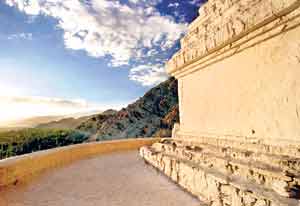 |
| Shey Chorten in the setting sun |
Woollen cloth, Khotanese carpets, Chinese silks, porcelain and silver came via Tibet; iron, dyes, sugar, spices and cotton came from India and Nepal. Basic food grains, yak butter (famously produced in secluded Zanskar), salt, wool, potatoes, barley and meat were (and are) commonly bartered at local fairs by communities along the way, such as those in Gartok (west Tibet, near Lake Mansarovar).
Caravans of mules and pack horses (still seen today) - sometimes sheep - carried heavy goods through the treacherous high passes of Ladakh; some areas in Zanskar were accessible to such packs only over frozen rivers in winter.
Diplomats of the ancient world
Much of the Leh-Yarkand trademark caravan trade was surprisingly conducted by merchants from Khokand, an old Islamic khanate in Ferghana Valley (today’s northern Uzbekistan), through which I had travelled in 1999 (see “The Wild Flower Meadows of Kyrgyzstan”, ST, November 11th, 2007). In 1887 Francis Younghusband, the English adventurer, gives this very apt description of these remarkable traders :
“It is in these [caravan] serais that one meets the typical travelling merchants of Central Asia, and often have I envied these men their free, independent, wandering life, interspersed with enough of hardships, of travel, and risks in strange countries to give it a relish. They are always interesting to talk to: intelligent, shrewd, full of information…they are very cosmopolitan, and do not really belong to any country except that in which they are at the time living. And this habit of rubbing up against men of so many different countries gives them a quiet, even temperament and breadth of idea which makes them very charming company.”
The rise of religious trade
in western Tibet
Religion forms an inextricable bond with Ladakh historically and the region, as with many former Silk Road khanate areas I have seen, is an inexact potpourri of races. Ladakhis are of mixed race, with the Changpa mongoloid nomadic shepherds from the upper plateaus of Tibet being the old forerunners thousands of years ago. They were joined later by lowland Indians (the “Mon” people), largely craftsmen and cultivators as well as followers of emerging Buddhism, who slowly populated the lower valleys. With their arrival, many fortifications arose and Indian artistic influences (from carpentry to music) began to infuse Tibet. Thereafter, by about 7C AD, the “Dards”, Aryans (to become nomadic pastoralists) from Muslim Hunza in today’s northern Pakistan began to move into the region, and became also known as “Drugpas”. Trade between Changpas and Dards thrived around 7C AD as Tibet’s own influence over Ladakh strengthened. They were later joined by the “Balti” trader Muslims from Baltistan, today in Pakistan. With the ebb and sway of these communities and their symbiotic interaction with others on the greater Silk Road, Ladakh itself grew in fame though always strongly meshed spiritually with older Buddhist Lhasa, its neighbour 1400 kilometres away.
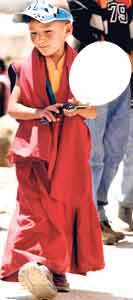 |
| A boy monk carrying a
toy pistol |
Much of this “trade” was, however, under the religious shadow that the once vibrant and uniquely Tibetan kingdom cast over this whole region in excess of a millennia. Indeed many of the countless trading missions and the socio-economic interactions trade spawned had distinct quasi religious motives : Ladakhi and Bhutanese tributes to Tibet, even of Tibet to China, and the protection of lama monks and monastic dues that helped foster and stimulate it. Envoys in charge of religious missions were, for example, accorded specific privileges of private trade, with free carriage given by people living along the trade routes. Even Buddhist monasteries routinely effected trade, as did wandering “trading pilgrims”, in as much as private traders who followed. The cultural appendages that this produced no doubt help explain the heritage of religious life, processions, festivals and even dress seen today in Ladakh.
A mystical land ruled by spirits
Since India allowed international access into this isolated region in 1974 (restrictions still apply for instance to the fabled Zanskar valleys - Sri Lankans and Pakistanis are not welcome), Ladakh has been a magnet for travellers due to its atmospheric landscapes and predominant Buddhist flavour. With about 30 large monasteries (“gompas”) spread in isolated corners in an already remote region, with hundreds of smaller monasteries and shrines, this is a spiritually concentrated and connected land where the sense of “otherworldliness” was almost unrivalled. The Dalai Lama, a frequent visitor, is naturally revered by all; his photographs adorn shops in almost every settlement.
Most of the lamas are broadly divided into the “Duck pas”, or red caps, and the “Spiro goons”, yellow caps, with philosophical differences that transcend this brief article. Village life is still defined in relation to religious principles and the local monastery; the principal lama (“kasha”) and his subordinates carry great influence, for example in the spheres of education and “swaripa” ayurvedic medicine, over a population whose life seems resolutely spiritually arranged around colourful religious festivals held in the monasteries’ courtyards. Supernatural forces (as evidenced in ”thangkas” - religious paintings), divination of omens, harmful and helpful spirits and blessings thereof… continue to play a vital part of life amongst ordinary Ladakhis. Houses are painted in red to ward off ghosts, walls white to retain benevolent beings; monastic symbols (and personal amulets) abound.
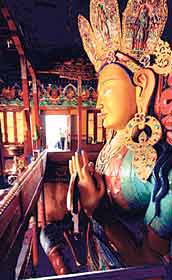 |
| The massive Maitreya
statue at Thiksey |
Reclusive “tantrikas” who master spirits, intervene for local needs and advise people on travel, activities, auspicious events, rites and donations to the lamas…while skulls of dogs, sheep and even humans are serenaded on poles at high points of buildings to ward off evil spirits. We may be in a so-called digital age but here spirituality and age-old human questions reign. In an environment as harsh, desolate and isolated as here, with the seasonal hardships of life that accompany, all these help to sustain the inner spirit of a gentle, smiling people defined by timeless customs.
Travelling across this landscape, I zigzagged to visit 10 of its more accessible monasteries dotted across the broad Leh valley (11,500 ft).
The Chortens of Shey Palace
South of Leh, the most cosmopolitan of towns in Ladakh and agreeably so, there lies the Shey Palace, the summer residence of the Ladakhi kings (15C AD). Climbing up the inevitable stairs to it (as always perched on a hillock), I wandered in the fading light of one afternoon, just before the main doors closed. The monastery particularly houses a 40 foot gold-copper plated Buddha statue inside. A huge chorten (dagoba), one of Ladakh’s largest, in the centre of the “palace” (-a collection of rooms including a library, some very dank and dark) towered skywards while the last rays of a setting sun brilliantly streamed through narrow passageways on its sides. I walked gingerly along a precarious two-foot wide crumbling ledge, anxious not to connect too prematurely with the past, and viewed a striking mud and wood façade of palace rooms; an unusual stretch of eight white smaller chortens aligned in a line on a religiously significant axis overlooked the vista of the valley below.
As I was leaving, a group of visiting local lamas with a senior figure at their centre emerged on a front balcony-courtyard, chatting amiably. I watched as one lama held aloft a string of prayer flags which he carefully tied to others fluttering across the courtyard, casting blessings to the wind. Far above him, some kilometres away, Thiksey monastery sat alone on a mountain ridge while clouds closed in, signalling the onset of dusk and casting huge floating shadows over vast swathes of terrain ahead like some great chess game. In Ladakh, light is everything; it punctuates the terrain at every instance and the resulting effects highlight the stark landscape in an exquisite manner. Little wonder, therefore, that paintings of demons and thunder are drawn so vividly!
Thiksey Gompa, the other
face of Potala
Thiksey is the alternative face of the Potala Palace at Lhasa, bearing such a general resemblance and positioning that it is a convenient pictorial double. Entering it, one is struck both by its deep red coloured walls, wood framed upper “apartment-styled” rooms, as well as the delightful hollyhock flower beds in its lower sections.
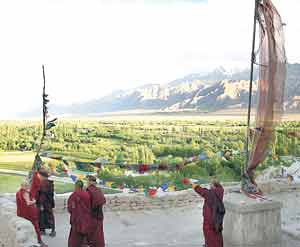 |
| Monks tying prayer flags at Shey |
The monastery houses a gold gilded statue of Maitreya which rises through two inner floors. As with every monastery in Ladakh, stunning views of a mountain-ringed valley filter through its windows. As I looked out of the room, a young adult lama in his red robes was playing joyfully in a mock wrestling match with a boy lama of about 8 years, a very distinctive boy whom I seemed to recognize instantly from a Cannes-prize winning film of Ladakh made a few years ago!
Shrines within shrines at Hemis Gompa
One of Ladakh’s biggest and wealthiest monasteries is Hemis Gompa, located up against the rear edge of a steep valley side about 45 kms from Leh. Dating to the early 17C AD, and with a vast array of rooms and courtyards, this takes some time to peruse. A centrepiece is the three storey statue of sage Padmasambhava of Swat (Guru Rinpoche). I entered its central dark and silent inner shrine room, with alcoves to various deities along its periphery and a long overhanging cloth “ears” of the Buddha; a room similar to many I had encountered in Bhutanese monasteries and the revered Tagong Monastery in remote grasslands of Kham plateau, Sichuan. Butter lamps flickered in much of the darkness but some natural light streamed through overhead shafts. Beautiful thangkas (it has the largest in Ladakh (40 ft) but unfurled every 12 years - next in 2016) and other ornate decorations and murals festooned the room and incense wafted across in a corner. I climbed barefoot to the roof of the monastery from where another stunning view back down the valley greeted me, as did two travelling elderly New York women, worshipping deities at every turn.
The rape fields of Chemery Gompa
Chemery monastery, a favourite, was larger and surrounded by stony mountains and beautiful fields of rape that framed it uniquely. A long rain-swept road ran up to its entrance through a desolate plain of huge glacial boulders and looked - from the monastery ledges - marvellously snake - like in pattern from on high. Inside, it featured a distinctive purple ceilinged painted courtyard and a shrine-side with many “rolling pin” prayer wheels. Peering out from its rooftop, serenaded with long stakes topped by spiritual motifs to ward off bad omens, I gazed across yellow fields into barren landscapes. The sense of isolation was distinct even though a small silent village lay below me. Unfortunately, most of its rooms were locked and not a single lama was in sight; they had all gone to a gathering at Hemis Gompa celebrating an 800th anniversary.
Cave murals of reclusive
Tak Thok Gompa
In a far corner of the valley 50 km from Leh and past Chemery, lies Tak Thok, the only black cap or Nyingma-pa order gompa. Tak Thok (“top of the rocks”) is tiny in comparison and built into a rocky hill, rather like a Sri Lankan rock temple. A mercifully short climb led to a small courtyard graced with bright murals. A further line of steps led into a dark cave.
The brightness of the day rendered me temporarily blind in the darkness, but gradually, after a frustrating 15 minutes, my eyes adjusted to the traditional Tibetan styled murals and figurines around me. A young guardian monk, noticing my discomfort, lit butter lamps and in its yellow hues further drawings on the low cave ceiling - old and faded due to centuries of lamp smoke - materialised. Elsewhere, I visited half finished rooms overlooking beautiful village fields from high up. My only companions were chirping sparrows as they wheeled around this absolutely silent location.
Hollyhocks and grass
courtyards : Alchi Gompa
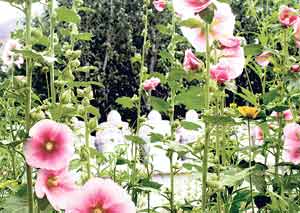 |
| Hollyhocks in abundance at Alchi monastery |
Back on the road to Kashmir and 70 km from Leh, I visited Alchi monastery, renowned for some of the region’s oldest murals dating from about 11C AD.
This was one of the few shrines where one could walk down rather than climb up! In a series of interlocking small white walled garden courtyards along a gushing Indus river, and overflowing with fresh grass, some apricot trees and numerous hollyhock beds, I followed a line of local pilgrims, lamas and a few foreigners. We jostled through narrow doorways into five temple shrine rooms, lit by torchlight.
Though housing acclaimed Indo-Tibetan art forms, many of the publicly visible murals had faded, and few had the brilliance of many such Buddhist paintings I had seen travelling across Chinese Xinjiang.
Festival times at Spittuk Gompa
A few dusty kilometres off the main Leh-Srinagar road a religious festival was taking place at Spittuk Monastery (15C). The monastery was packed with locals and foreign visitors when I arrived. In the central courtyard, a series of slow dances, with lamas wearing an array of masks representing gods, animals and demons, took place to the accompaniment of a rhythmic monastic orchestra armed with horns, cymbals and drums. The stories they acted were not apparent to the onlooker, but an articulate local visiting lama explained some of its meanings to me. Meanwhile two other dancers, with comic shaggy maned masks circulated through the crowd, making local jokes and collecting donations.
Later, I ambled in the adjacent village fair and spotted a barely seven-year-old boy-monk happily brandishing a balloon and plastic pistols as he played an imaginary shootout with a local urchin. It reminded me that children are children everywhere, holy or not. Rather poignantly, however, months later this memory (omen?) symbolically fused with the ugly military scenes that were taking place in Burma against the clergy and the less traumatic Tibetan demonstrations in Lhasa.
Vistas of Stok
One of my last nights in Ladakh was spent in a lonely but extremely panoramic guesthouse, with only my two children and I as sole occupants. The scene from Stok (housing a monastery and a palace for Ladakh’s last royalty) across the valley side from Leh, was dazzling. Memorably too, no bathroom in the world could match the view from my toilet window. It took some convincing of the solitary staff to give us a little generator light (and food) at night. In the morning, seated out in the isolated garden fringed by chorten ruins nearby, a surreal breakfast was consumed under impeccably blue skies and a vast open landscape, uniquely Ladakh.
Well above the “noise” of the modern world, Ladakh still maintains a serenity that even only a few Silk Road regions can match and many of its far flung corners will continue to retain spiritual sanctity and earthly beauty for time to come. My only regret was inaccessibility to some inner areas due to political shortsightedness, and the frustrating - road barred - nearness to western Tibet’s (now China) ancient Guge kingdom above Ladakh that I long wished to see. To do that one needs today to make a nonsensical 3340 kilometre detour which I will have to do one day.
meridiana@sltnet.lk |





